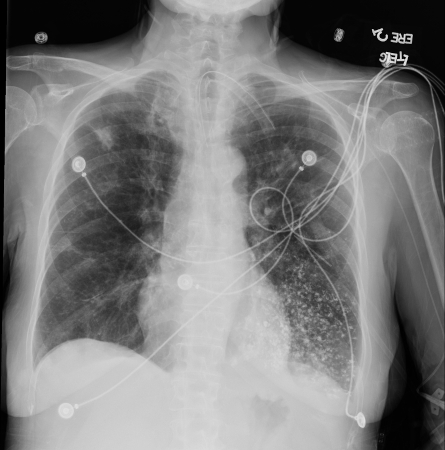Case history
Case history #1
A 62-year-old woman with systemic lupus erythematosus undergoes a head magnetic resonance imaging for acute mental status changes suggesting lupus cerebritis. The patient has been taking prednisone each day for several months. She has a diagnosis of GERD, for which she takes a proton-pump inhibitor. During the imaging study in the supine position, the patient vomits and aspirates gastric contents consisting of yellowish-greenish fluid. Severe respiratory distress and hypoxemia develop, and she requires endotracheal intubation, mechanical ventilation, and admission to the intensive care unit. Physical exam reveals bilateral crackles and wheezes.
Case history #2
An 80-year-old male with a past medical history of ischemic stroke, COPD, obstructive sleep apnea (noncompliant with noninvasive ventilation), and diabetes mellitus presents after being found by his partner with altered mental status. He had undergone a recent dental procedure and had been managing his pain with opioids. Physical exam reveals severe hypoxemia and the patient requires immediate intubation for airway protection. Right-sided crackles are identified on auscultation. Imaging reveals dense right lower lobe consolidation.
Other presentations
Aspiration is more common in older patients who have comorbid conditions that may lead to altered mental status. This population includes patients with swallowing dysfunction, disruption of the gastroesophageal junction, or anatomic abnormalities of the upper airway or digestive tract. Additionally, patients undergoing upper airway or endoscopic procedures are at risk. Any situation in which mental status is altered and airway protection mechanisms are lost increases the risk of aspiration. Limited protection is provided by a nasogastric tube, a percutaneous endoscopic gastrostomy, or an endotracheal or tracheostomy tube, and in fact they may increase the risk.[2] Patients with aspiration of gastric contents can develop aspiration bronchiolitis, pneumonitis, pneumonia, and acute respiratory distress syndrome. Patients with neurologic deficits, infants, older patients, and debilitated patients with dysphagia may aspirate barium sulfate during radiologic procedures, which can result in severe pneumonitis and death.[4][Figure caption and citation for the preceding image starts]: Bronchoscopy showing barium aspiration in a lung transplant patient in the right mainstem bronchus after a barium swallow studyFrom the collection of Dr Kamran Mahmood [Citation ends]. [Figure caption and citation for the preceding image starts]: Barium aspiration. A barium swallow was conducted in a 53-year-old woman. Imaging revealed hyperdense airway-centered material in the left lower lobe consistent with barium aspiration bronchiolitis. A tracheoesophageal fistula was confirmedFrom the collection of Dr Augustine Lee; used with permission of Mayo Foundation for Medical Education and Research, all rights reserved [Citation ends].
[Figure caption and citation for the preceding image starts]: Barium aspiration. A barium swallow was conducted in a 53-year-old woman. Imaging revealed hyperdense airway-centered material in the left lower lobe consistent with barium aspiration bronchiolitis. A tracheoesophageal fistula was confirmedFrom the collection of Dr Augustine Lee; used with permission of Mayo Foundation for Medical Education and Research, all rights reserved [Citation ends].
Use of this content is subject to our disclaimer